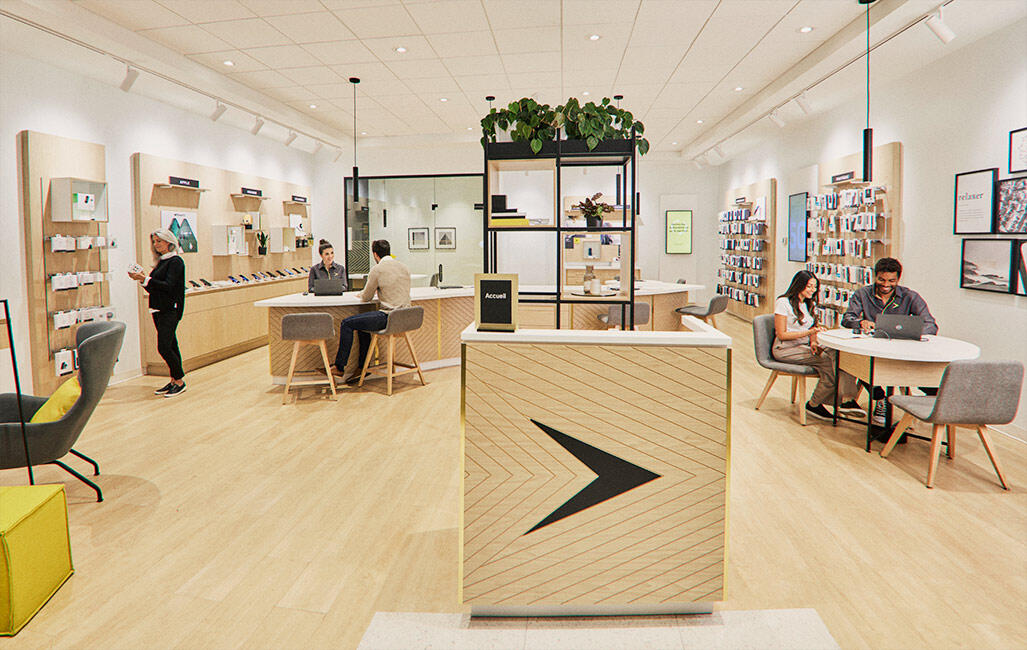
Particularly in times of crisis, technology plays a crucial role for companies striving for growth and stability. In fact, every major upheaval is a good time to deploy an arsenal of innovations that enrich the customer experience.
In what way are technology, digital transformation, and artificial intelligence powerful allies during a crisis? Here’s an overview of a few advances and inspiring strategies.
Technology and COVID-19: A driver of prosperity?
Since the spring of 2020, companies around the world, including in Québec, have been busily setting up initiatives aiming to reduce the impacts of the pandemic. Some companies have reinvented themselves during the crisis, through the production of medical equipment. The novel coronavirus has put innovation and responsiveness centre-stage. At this time, companies are more proactive than ever before, knowing that the pandemic is here to stay. There is a greater understanding of the impacts, and we can now anticipate what comes next in the event of another confinement.
In March, an article by the World Economic Forum listed the major trends that were intended to alleviate the economic shock of COVID-19. The list is long: online shopping, contactless payment, delivery robots, teleworking, telemedicine, distance learning, entertainment, supply chain management systems, 3D printing, drones, and the deployment of 5G.
E-commerce: Figures that speak for themselves
In many sectors, the lockdown has caused an explosion in online shopping. While the international big players are taking up a lot of that space, many local initiatives have also launched: Panier Bleu, a huge digital showcase of Québec-based businesses, comes immediately to mind.
An application like the Montréal-based Booxi for appointment-making—covering everything from reservations to billing and including a notification feature—facilitates the social distancing required by health authorities.
Integrated into a point-of-sale terminal just like that early Québec unicorn, Lightspeed, the Booxi app is shining on both sides of the Atlantic.
As for long-term repercussions, the study’s authors note that “small businesses are increasingly turning to e-commerce platforms and are using these platforms in innovative ways […] Clearly, the retail landscape will evolve.”
Good to know
At the end of July, Statistics Canada announced record highs in the e-commerce sector. Retail sales reached an unprecedented $3.9 billion in May, up 2.3% from April and 99.3% from February!
Robots lend a helping hand during the pandemic
In terms of delivery, robots are also making inroads into our homes! Autonomous delivery robots, such as those deployed by Amazon, FedEx, or Alibaba, will likely be in circulation in increasing numbers in the coming years.
Physical distancing guidelines have also led many government agencies, sectors, and organizations to equip themselves with robots, which make for the perfect automated helpers for certain tasks, and also provide increased hygiene and precision, particularly in the hospital sector. In a few cities, robots have even been circulating on the streets to enforce the lockdown.
In Montréal’s International District, Monville Hotel has become part of a wave of connected establishments. Opened in 2018, the 20-storey hotel can deliver room service in record time thanks to a robot! Computer terminals and a key distributor round off this list of connected yet humane services. Remaining open during the pandemic, the Monville also converted certain rooms into meeting spaces and private offices.
Drones: A technology taking flight
In March 2020, Business Insider journalist Lisa Eadicicco reported the story of Vakis Demetriou, a man confined in Cyprus due to the coronavirus. The restrictions he endured gave rise to an idea: he began using a drone to walk his dog. The Cypriot video of his solution, published on Facebook, became a viral hit, demonstrating the infinite potential for such devices.
Whether used for delivery (for which Amazon has invested significant sums) or surveillance, drones continue to surprise us. In Québec, some municipalities are using them more and more for locating lost individuals or people trapped inside burning buildings.
Also within our borders, Agence QMI reported last year that the McGill University Health Centre (MUHC) was testing the use of drones to transport medical supplies such as defibrillators or blood products. This is just one area of drone use that will likely increase in coming years.
Distance learning
Zoom, Meet, Teams, WebEx, Skype, Reactions and so on . . . these videoconferencing solutions came into our lives like a tsunami, becoming powerful communication, socializing, and professional team-building tools. In fact, their growing use could completely change the way we approach human resources.
To make life at home easier, new cloud solutions have also emerged. Instead of buying individual licences, some packages with monthly fees now come with a wide range of advanced telephone options, such as teleconferencing and chatting. Videotron Business has set up a package for companies, which includes collaboration tools as well as traditional telecommunication services (Mobility, Internet). You can now meet virtually with 15 colleagues, just like at the office!
These various technological solutions are very useful in education, particularly in the context of the pandemic. As part of this trend, courses and distance training have also changed aspects of the student and educational reality. Once you’ve been able to tame the multitude of videoconferencing interfaces, many users are able to see their advantages, particularly in terms of reducing commuting time, despite the fact that certain elements still need to be added, particularly to facilitate teacher-student interactions, reliability and teamwork, amongst others.
The good news is that, despite these integration and adaptation challenges, distance learning enables many workers located outside urban centres to take advantage of courses, webinars, and training that would otherwise be inaccessible.
Health in the future: Telemedicine and artificial intelligence
Science and medicine are integral to coronavirus prevention, care, and recovery. An Agence France-Presse article last spring reported on the use of several technologies, namely “a robot capable of sorting patients, artificial intelligence that could analyze X-rays, the decoding of the virus’ genome, and vaccine research vaccine,” on the African continent, in Tunisia. »
In other countries, AI has supported the prediction and understanding of some sources of outbreaks and spreading of the virus, or the diagnosis of certain potentially infected patients. Similarly, at the end of July, Health Canada launched the free COVID Alert app, adopted by many provinces, including Québec. The application can send an alert if you have been in contact with someone who has been positively diagnosed with coronavirus in recent weeks.
Deep learning or even mathematical and statistical modelling can become important allies when it comes to digital tracing. Naturally, confidentiality is an important concern, since the combination of illness and technology naturally invites ethics into the issue.
With such issues in mind, the Québec government drafted Pandémie de COVID-19 : les technologies à la rescousse? (The COVID-19 Pandemic: Technology to the rescue? – available in French only), which sets out certain observations and reflections on the subject.
Connected objects are also popular
Consider smart thermometers like QuickCare and Smart Ear by Kinsa. Connected to a network, they can track historical data, offer advice, and even contribute to the detection or communication of information related to COVID-19.
Telemedicine is also taking giant leaps forward, particularly to counteract potential overcrowding at physical hospitals, amongst other uses.
In many respects, its super-fast integration is very good news, in addition to the fact that it significantly helps people living in remote regions or who have mobility issues. Sites such as Rendez-vous santé Québec and Bonjour-Santé are good references, while professionals in Québec’s health networks have recourse to their own online reference, telesante.quebec.
In addition to facilitating the doctor-patient relationship, in some instances, telemedicine is also beneficial for communications between professionals, to practise or guide an intervention remotely, assist users, perform at-home follow-ups, and facilitate the circulation of information within clinics in the network.
Smart wristbands as a response to the crisis
Simple, robust, and high-performance, smart wristbands are increasing in popularity. In many cities and countries, they’re used to mitigate the risk of spreading the virus. In Québec, the Radius wristband provides a clever solution to companies for encouraging social distancing in an effective yet friendly manner. If the COVID Alert app developed by Health Canada notifies you in case of contact with an infected person, the Radius wristband, for its part, acts as a preventive, complementary solution. The new Radius wristband solution by Videotron Business alerts people when they are in too-close proximity to one another.
Created and manufactured in Québec, Radius uses Bluetooth to detect when users are located too close to others, then notifies them using vibrations and lights. The wristband also interacts with terminals set up in high-traffic areas.
In case of infection, a manager can view the history of interactions detected and use the anonymous data in the management portal to define an internal action plan. The anonymity of the data is an important feature.
The Radius technology primarily targets behaviours. Each wristband is associated with a unique identifier specific to the company, and that place of business is the only entity to know the identity of the wristband wearer to be infected with COVID-19.
It’s a simple, ethical solution that does not require geolocation and that fosters respect for sanitary regulations, reduces the risk of coronavirus transmission, and maintains the privacy of individuals and organizations. In the event of an outbreak, the Radius wristband allows company managers to act quickly by protecting all their staff, while avoiding having to close their offices, thus limiting any major impact on productivity.
While the pandemic will end one day, technology, for its part, will continue to advance and spread—to humanity’s benefit.
15 October 2020, By Videotron Business






